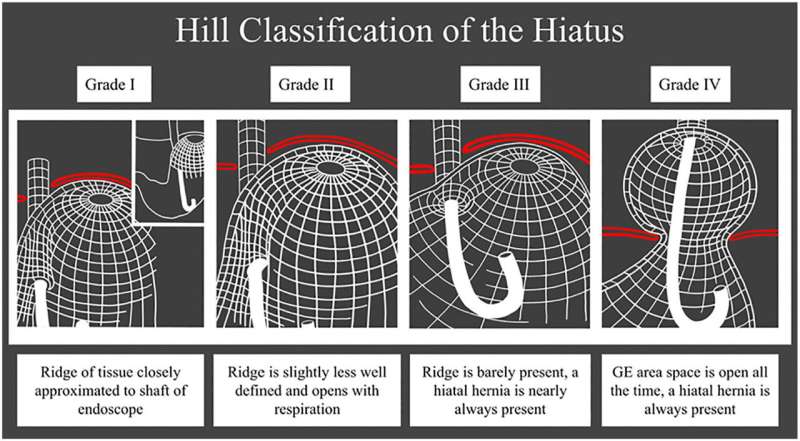This article has been reviewed according to Science X's editorial process and policies. Editors have highlighted the following attributes while ensuring the content's credibility:
fact-checked
trusted source
proofread
White paper recommends expanding endoscopic classification of esophagogastric junction integrity beyond hill grade

A new white paper by the American Foregut Society recommends expanding the classification of the esophagogastric junction (EGJ) to increase an assessment of the axial hiatal hernia length, hiatal hernia aperture diameter, and presence or absence of the flap value, making it more comprehensive. The white paper is published in the December issue of Foregut, the only subscription journal focused exclusively on foregut disease linking medical, endoscopic, and surgical disciplines.
Gastrointestinal reflux disease (GERD) is one of the most common and debilitating esophageal conditions, affecting about one in five American adults. The Hill grade is an endoscopic classification of the EGJ based on the appearance of the gastroesophageal flap from a retroflexed view of the hiatus. This endoscopic classification gives healthcare providers insights into the anatomic disruption of the EGJ that often correlates with GERD.
However, with the advent of newer endoscopic treatment options for GERD, members of the American Foregut Society (AFS) convened a working group to review the Hill grade classification and formulate a proposal to revise this system based on the Delphi method. In the white paper, the task force recommends a new classification that would stratify EGJ integrity from normal (grade 1) to increasing degrees of EGJ disruption (grade 2-4) beginning with the loss of flap valve and progressing to increasing degrees of crural disruption and hiatus hernia.
"Although the Hill grade provides important clinical information and insight into an anatomic mechanism of GERD, its routine utilization in endoscopic practice has been limited due to skepticism as to its relevance and the perceived subjectivity in its application," said Kate Freeman, Executive Director of AFS, the only organization dedicated to the diagnosis and management of foregut disease through collaboration between gastroenterologists and surgeons.
"With a broader understanding of the anatomic mechanisms of the antireflux barrier including the crura of the diaphragm, the lower esophageal function, and its sling fibers, and the flap valve and the integral relationship between them, the new AFS classification expands on the grading classification by including assessment of the hiatus aperture, objective extent of hiatal axial length and the presence or absence of the flap valve, making it much more comprehensive."
About the white paper
The AFS working group was comprised of 13 members tasked with developing an improved classification scheme for endoscopically gauging the endoscopic integrity of the EGJ. The group was composed of experts in foregut disease from gastroenterology (n = 7) and gastrointestinal surgery (n = 6). The expert consensus discussion was based on a modified Delphi method. A series of surveys that critiqued the Hill classification were circulated among the group and suggested improvements were solicited.
Based on survey results and the working group's discussion, a proposal for a revised anatomic classification of the EGJ was developed. Following the initial virtual meeting, additional smaller group meetings were convened to further refine the preliminary proposal. Based on these discussions, a new classification was proposed and named the AFS endoscopic classification of EGJ integrity.
This new classification is comprehensive in nature and seeks to improve the physiological relevance of the grading classification, to standardize the endoscopic methodology in applying it, and proposes nomenclature for endoscopic grading. A key difference of the new classification is that it focuses not only on the flap valve but also on the anatomic disruption of the diaphragmatic hiatus (crural separation) and the axial extent of hiatal herniation with an understanding that all 3 variables are integrally related and impact the ARB.
More information: Ninh T. Nguyen et al, The American Foregut Society White Paper on the Endoscopic Classification of Esophagogastric Junction Integrity, Foregut: The Journal of the American Foregut Society (2022). DOI: 10.1177/26345161221126961



















